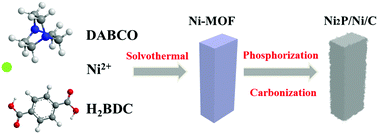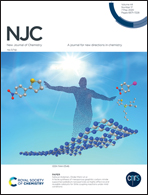Rationally designed Ni2P/Ni/C as a positive electrode for high-performance hybrid supercapacitors†
Abstract
N-Doped carbon-incorporated Ni2P/Ni was reasonably designed and synthesized from nickel-based metal organic framework (Ni-MOF) precursors via a novel simultaneous carbonization and phosphatization process. Interestingly, subtle phosphating significantly improves the energy storage performance of supercapacitors (SCs). Ni2P/Ni/C composites exhibit a good energy storage performance with a specific capacitance of 257.2 C g−1 at 1 A g−1. The corresponding hybrid supercapacitor achieves an energy density of 25.4 W h kg−1 at a power density of 750 W kg−1, ultrahigh electrochemical cyclic stability (98.2% retention after 4000 cycles) and nearly 100% coulombic efficiency with a Ni2P/Ni/C-100 positive electrode and a porous carbon negative electrode, respectively. These can be attributed to the synergetic effects of N-doped carbon and metal phosphates, which ensure good electrical conductivity and provide rich reactive sites as well as stable architecture. These results indicate that the controlled pyrolysis of MOFs is an effective method to design a kind of high-performance electrode material for hybrid supercapacitors.



 Please wait while we load your content...
Please wait while we load your content...